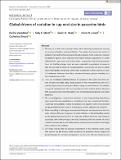Global drivers of variation in cup nest size in passerine birds
Abstract
1. The size of a bird's nest can play a key role in ensuring reproductive success and is determined by a variety of factors. The primary function of the nest is to protect offspring from the environment and predators. Field studies in a number of passerine species have indicated that higher-latitude populations in colder habitats build larger nests with thicker walls compared to lower-latitude populations, but that these larger nests are more vulnerable to predation. Increases in nest size can also be driven by sexual selection, as nest size can act as a signal of parental quality and prompt differential investment in other aspects of care. It is unknown, however, how these microevolutionary patterns translate to a macroevolutionary scale. 2. Here, we investigate potential drivers of variation in the outer and inner volume of open cup nests using a large dataset of nest measurements from 1117 species of passerines breeding in a diverse range of environments. Our dataset is sourced primarily from the nest specimens at the Natural History Museum (UK), complemented with information from ornithological handbooks and online databases. 3. We use phylogenetic comparative methods to test long-standing hypotheses about potential macroevolutionary correlates of nest size, namely nest location, clutch size and variables relating to parental care, together with environmental and geographical factors such as temperature, rainfall, latitude and insularity. 4. After controlling for phylogeny and parental body size, we demonstrate that the outer volume of the nest is greater in colder climates, in island-dwelling species and in species that nest on cliffs or rocks. By contrast, the inner cup volume is associated solely with average clutch size, increasing with the number of chicks raised in the nest. We do not find evidence that nest size is related to the length of parental care for nestlings. 5. Our study reveals that the average temperature in the breeding range, along with several key life-history traits and proxies of predation threat, shapes the global interspecific variation in passerine cup nest size. We also showcase the utility of museum nest collections—a historically underused resource—for large-scale studies of trait evolution.
Citation
Vanadzina , K , Street , S , Healy , S D , Laland , K & Sheard , C 2023 , ' Global drivers of variation in cup nest size in passerine birds ' , Journal of Animal Ecology , vol. 92 , no. 2 , 13815 , pp. 338-351 . https://doi.org/10.1111/1365-2656.13815
Publication
Journal of Animal Ecology
Status
Peer reviewed
ISSN
0021-8790Type
Journal article
Description
Funding: Systematics Research Fund 2019 to KV. John Templeton Foundation (Grant Number(s): #60501; Grant recipient(s): Kevin N Laland).Collections
Items in the St Andrews Research Repository are protected by copyright, with all rights reserved, unless otherwise indicated.

